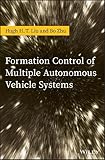Formation control of multiple autonomous vehicle systems / Hugh H.T. Liu, Bo Zhu.
By: Liu, Hugh H. T [author.] .
.
Contributor(s): Zhu, Bo (Mechanical engineer) [author.] .
.
Material type:  BookPublisher: Chichester, West Sussex, UK : Wiley, 2018Edition: First edition.Description: 1 online resource.Content type: text Media type: computer Carrier type: online resourceISBN: 9781119263050; 1119263050; 9781119263043; 1119263042; 9781119263081; 1119263085.Subject(s): Autonomous vehicles -- Case studies
BookPublisher: Chichester, West Sussex, UK : Wiley, 2018Edition: First edition.Description: 1 online resource.Content type: text Media type: computer Carrier type: online resourceISBN: 9781119263050; 1119263050; 9781119263043; 1119263042; 9781119263081; 1119263085.Subject(s): Autonomous vehicles -- Case studiesIncludes bibliographical references.
"Presents representative case studies in selected applications in space, aerial, and robotic systems domains. - Introduces an experimental platform of using laboratory three-degree-of-freedom helicopters with step by step instructions as an example and exercises throughout the book for illustration purposes. - Open Source example models and simulation codes will be provided Marketing description- Primary: Researchers and academics in robotics and unmanned systems looking at formation problems. These include mechanical engineers, aerospace engineers and electrical engineers. Graduate students in Control within ME, EE, and AE are also a target as a supplemental publication. Secondary: Industry engineers developing guidance systems for formation control systems and graduate students in mechanical, electrical, and aerospace engineering"-- Provided by publisher.
Description based on print version record and CIP data provided by publisher.
Cover; Title Page; Copyright; Contents; Preface; List of Tables; List of Figures; Acknowledgments; Part I Formation Control: Fundamental Concepts; Chapter 1 Formation Kinematics; 1.1 Notation; 1.2 Vectorial Kinematics; 1.2.1 Frame Rotation; 1.2.2 The Motion of a Vector; 1.2.3 The First Time Derivative of a Vector; 1.2.4 The Second Time Derivative of a Vector; 1.2.5 Motion with Respect to Multiple Frames; 1.3 Euler Parameters and Unit Quaternion; Chapter 2 Formation Dynamics of Motion Systems; 2.1 Virtual Structure; 2.1.1 Formation Control Problem Statement.
2.1.2 Extended Formation Control Problem2.2 Behaviour-based Formation Dynamics; 2.3 Leader-Follower Formation Dynamics; Chapter 3 Fundamental Formation Control; 3.1 Unified Problem Description; 3.1.1 Some Key Definitions for Formation Control; 3.1.2 A Simple Illustrative Example; 3.2 Information Interaction Conditions; 3.2.1 Algebraic Graph Theory; 3.2.2 Conditions for the Case without a Leader; 3.2.3 Conditions for the Case with a Leader; 3.3 Synchronization Errors; 3.3.1 Local Synchronization Error: Type I; 3.3.2 Local Synchronization Error: TypeII.
3.3.3 Local Synchronization Error: TypeIII3.4 Velocity Synchronization Control; 3.4.1 Velocity Synchronization without a Leader; 3.4.2 Velocity Synchronization with a Leader; 3.5 Angular-position Synchronization Control; 3.5.1 Synchronization without a Position Reference; 3.5.2 Synchronization to a Position Reference; 3.6 Formation via Synchronized Tracking; 3.6.1 Formation Control Solution 1; 3.6.2 Formation Control Solution 2; 3.7 Simulations; 3.7.1 Verification of Theorem 3.12; 3.7.2 Verification of Theorem 3.13; 3.7.3 Verification of Theorem 3.14; 3.8 Summary; Bibliography.
Part II Formation Control: Advanced TopicsChapter 4 Output-feedback Solutions to Formation Control; 4.1 Introduction; 4.2 Problem Statement; 4.3 Linear Output-feedback Control; 4.4 Bounded Output-feedback Control; 4.5 Distributed Linear Control; 4.6 Distributed Bounded Control; 4.7 Simulations; 4.7.1 Case 1: Verification of Theorem 4.1; 4.7.2 Case 2: Verification of Theorem 4.5; 4.8 Summary; Chapter 5 Robust and Adaptive Formation Control; 5.1 Problem Statement; 5.2 Continuous Control via State Feedback; 5.2.1 Controller Development; 5.2.2 Analysis of Tracker ui0.
5.2.3 Design of Disturbance Estimators5.2.4 Closed-loop Performance Analysis; 5.3 Bounded State Feedback Control; 5.3.1 Design of Bounded State Feedback; 5.3.2 Robustness Analysis; 5.3.3 The Effect of UDE on Stability; 5.3.4 The Effect of UDE on the Bounds of Control; 5.4 Continuous Control via Output Feedback; 5.4.1 Design of ui0 and d^i; 5.4.2 Stability Analysis; 5.5 Discontinuous Control via Output Feedback; 5.5.1 Controller Design; 5.5.2 Stability Analysis; 5.6 GSE-based Synchronization Control; 5.6.1 Coupled Errors; 5.6.2 Controller Design and Convergence Analysis.


There are no comments for this item.